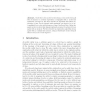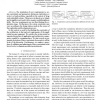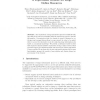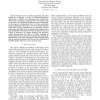99
Voted
ATAL
2003
Springer
15 years 6 months ago
2003
Springer
Much emphasis in multiagent reinforcement learning (MARL) research is placed on ensuring that MARL algorithms (eventually) converge to desirable equilibria. As in standard reinfor...
78
Voted
STACS
2004
Springer
15 years 6 months ago
2004
Springer
Under the robot model, we show that a robot needs Ω(n log d) bits of memory to perform exploration of digraphs with n nodes and maximum out-degree d. We then describe an algorith...
99
Voted
SAMOS
2004
Springer
15 years 6 months ago
2004
Springer
Abstract— The translation of user requirements to system constraints and parameters during an exploration exercise is a hard problem, especially in the context of large scale emb...
103
Voted
EKAW
2004
Springer
15 years 6 months ago
2004
Springer
The exploration of large information spaces is a difficult task, especially if the user is not familiar with the terminology used to describe information. Conceptual models of a do...
82
Voted
ICRA
2005
IEEE
15 years 6 months ago
2005
IEEE
— Recent work on robotic exploration and active sensing has examined a variety of information-theoretic approaches to efficient and convergent map construction. These involve mo...
121
Voted
ICRA
2005
IEEE
15 years 6 months ago
2005
IEEE
Motion planning for robots with many degrees of freedom requires the exploration of an exponentially large configuration space. Single-query motion planners restrict exploration ...
108
click to vote
ICRA
2006
IEEE
15 years 6 months ago
2006
IEEE
Abstract— The mapping and localization problems have received considerable attention in robotics recently. The exploration problem that drives mapping has started to generate sim...
110
Voted
CSMR
2006
IEEE
15 years 6 months ago
2006
IEEE
Recovering the architecture is the first step towards reengineering a software system. Many reverse engineering tools use top-down exploration as a way of providing a visual and ...
SMC
2007
IEEE
15 years 7 months ago
2007
IEEE
—Reinforcement learning is a framework in which an agent can learn behavior without knowledge on a task or an environment by exploration and exploitation. Striking a balance betw...
98
Voted
ICRA
2008
IEEE
15 years 7 months ago
2008
IEEE
— Computationally efficient motion planning must avoid exhaustive exploration of configuration space. We argue that this can be accomplished most effectively by carefully balan...




